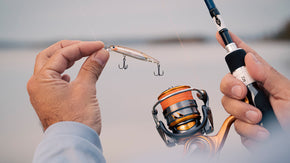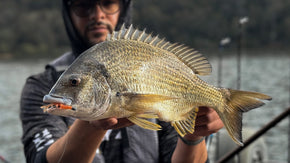Posted 05th June 2025
Product Review: Infeet Metal Vibe


By Joshua Bland
It’s been a while since I picked up a metal blade. Their overwhelming success for both new and experienced anglers has been somewhat of a turn-off for me. My toxic idea that something easy isn’t earned, that something simple shouldn’t be as effective as something complex. Which is why when John Murdaca, Mr Bait Junkie himself, passed me a prototype across the table, I felt a mix of contempt and confidence for the task ahead of me. I would end up not only testing the lure, but my preconceptions of what fishing is all about.

Like all good things, the metal vibes have an origin story. It is the successor of the Steez Blade, a lure best remembered for its ability to tangle in the mainline with minimal effort. I can't recall whether I pulled out more tangles or hairs on my head, I do recall it catching me lots of fish, though. After the initial run with this design, the Daiwa team elected to discontinue it with visions of something greater. John has since made it his mission to make this version, now underneath the Infeet umbrella, not only better than its predecessor but the most capable and user-friendly bladed lure ever designed. This is a grand target; let’s see if it hits the mark.
Features Overview
On the onset, the Infeet Metal Vibe takes on the traditional fish shape with a large headbearing most weight, followed by a thin, tapering body section. The distinction between the head and body sections is clear, with a splayed belly section more pronounced than competitors in this category. This forward weighted design has been modelled intuitively to improve the transfer of momentum through the cast whilst simultaneously creating a more stable projectile as it travels through the air. This stability is key to limiting the rear or front treble from doubling back on the mainline, thus fouling the cast.
This unique weight distribution, specifically the flared belly weight, is the grand design of

this lure. It has been intuitively designed into a type of hydrofoil. This is particularly impactful as it resolves previous issues whilst imbuing new functional advantages. Unlike other blade designs, this Infeet version does not flutter on the drop. Instead, it has a controlled, horizontal sink on an angle. This is the hydrofoil in action, allowing the lure to glide during the fall without tangles. The lateral flare creates a large surface area at the lure’s lowest point. This reduces startup inertia to create instant vibration and simultaneously increases the distance between the mainline and the belly treble to prevent fouling. It also allows more weight to be fitted into the lure without increasing its size or the thickness of the body. Finally, the large surface area provides a flat platform, which, in my experience, makes it bounce over rubble or reef terrain without getting stuck.
Immediately behind the head, we find a new triangular arrangement of three clip holes: one on the bottom, two at the top. The lower hole creates a subtle, tight vibration due to its lower centre of gravity, best suited to finesse approaches. The two top holes create a more violent vibration, with the rear being the most responsive of all options, better for active presentations. Moving to the rear of the metal vibe, we find two rigging holes. The bottom is for standard trebles, and the top is for assist hooks. The bottom rigging hole is positioned lower and further forward than normal, which makes it impossible for the rear treble to fold over the top of the tail and contact the mainline. The top rigging hole, however, is positioned at the tip of the tail, allowing complete freedom of movement for assist hooks to improve hook-up rate.
The lure is donned with a complement of high-quality BKK Spear 21 super-slicks and standard split rings and clips. Speaking of clips, they are incredibly secure but can be a bit fiddly to take on and off for the smallest 3.5g size. Consider using fine pliers and check that the clasping end is thin enough to poke through the holes. It’s a delicate fit, and variations from the factory might mean a small squeeze with pliers might be required to bring it into line.
Finally, the colour range. At initial release, there are 10 colours to choose from, ranging from age-old classics like AYU and BLACK, to creative variants like CRAB CLAW and MUSSEL SHELL. This provides reliability to known patterns for different species whilst opening the door to emerging favourites. However, I think there is a missed opportunity for more colours with flash as a primary focus. Reflective gold or silver variants would be a welcome addition to the range, but based on Daiwa’s history of colour updates, I wouldn’t be surprised to see them added in the future.
Target Species
The metal vibe is a true multi-species lure due to its simple function and versatility. Estuary species like flathead, bream, and school mulloway all respond well to them. The ability to target drop-offs, surf gutters, and eddies in a very specific way makes them incredibly effective in these ambush areas. All perch and perch-like species, such as golden perch, estuary perch, bass, and redfin, absolutely love these blades. I would go as far as to say they are perhaps the most reliable and approachable way to catch them. In our golden perch competitions in South Australia, blades consistently result in an absurd number of fish. I suspect the release of this lure will fine-tune that success. Other honourable mentions are species that respond well to fast-moving metal lures, such as trout in impoundments, toothy critters like snook or pike, and small pelagics like tommies, Australian salmon, juvenile kingfish, tailor, mack tuna, bonito, or mackerel.

Techniques: When, where, and how?
The metal vibe is unlike most other lures, becoming extremely effective when fast sink, strong vibration, or flash become critical. High current, deep water, and dirty or stained water are all conditions in which this lure shines. This lure dominated black bream in the Coorong, which is notorious for its high flows and dirty water. Rigging the 7g size with assist hooks, I could drop the lure in the strike zone, tight to the reef, without it snagging or washing away. Each time the lure would hop out of a crevice, and it would get crunched.
This lure can be fished just about anywhere, including snag-prone areas such as rubble, weed and timber when fitted with assist hooks. The metal vibe is often fished in one of three ways: hopping, vertical jigging, and burning.
Hopping through short lifts of the rod mimics a wounded baitfish or fleeing shrimp/prawn and is an excellent technique for sand flats, weed edges or along rock walls. With each lift, you can let the lure free-fall on a slack line or support it on a taught line. A slack line will encourage the lure’s faster horizontal sink rate, whereas a taught line will slow the descent, which can be critical for fussy fish or species that eat it on the drop like perch.
Vertical jigging is one of the most effective ways to fish this lure if you are on a boat or kayak with a sounder. Because of the fast sink, you can very easily get it to depth. The high density of the metal construction returns well on a sounder, allowing you to spot the lure on the way down and work it at precise depths. I had lots of success targeting golden perch in this way in the lower Murray River. Parking up on a stack of timber or between willow branches, I jigged the lure in and around the structure to pull fish. This allowed me to stay in the strike zone longer and more effectively than most other techniques.
Burning is another common technique and lends to this lure’s capability as a searching bait. These blades cast like a rocket and can cover a large area. Burning it back over weed or sand flats can produce a reaction bite from species like trout and flathead when they are active. Playing around with the lure size and rate of retrieve will give you specific presentations that can be applied to your scenario. This can be narrowed further by changing the tow point: rear = slow retrieve, front = fast retrieve.
Gear Choice
Finesse setups are the best way to maximise the delicacy of design built into these blades. A 1000 - 2500 size spin or bait finesse system (BFS) reel paired nicely with an ultra-light action, fast to extra-fast taper rod in the 6’ 10” – 7’ 4” range is perfect. This will ensure you are invoking the most action out of the lure whilst ensuring the hooks stay pinned on those delicate bites. The Infeet EX and Z range of rods have specific models for the metal vibe, but there are also models in the TD Zero, Black, and Hyper ranges that will do the job nicely.
Recommended reels:
* 24 TD Black
* Reverly FC MQ
* 23 Exceler
* 24 Certate
* 23 Airity
* 22 Exist
Recommended rods:
* 22 Infeet SK 732ULFS
* 23 Infeet Z 732ULFS
* 23 Infeet EX 722ULFS
Suitable rods:
* 23 TD BLACK GRUB'N 722ULFS
* 22 TD ZERO 722ULXS
* 23 TD HYPER 702ULXS
Any fast-action rod with a 1 – 7 g cast weight.
The choice is yours between braid and fluorocarbon, though in most instances, braid will be superior. This will allow your blade to sink to the bottom faster, cut through weed better, and retain sensitivity to feel the bottom type and detect fouling. Pair it with a strong fluorocarbon leader like J-Thread X-Link FC, and you have a deadly metal vibe set up. Fluorocarbon, though, has its advantages with abrasion resistance and shock absorption. It is something to consider if you vertically jig timber for species like bass and golden perch.
Final Thoughts
The Infeet Metal Vibe fills a gap in the Daiwa lineup that has been sorely missed. This new design incorporates intelligent design whilst fixing the issues that plagued its predecessors. With blades being one of the most versatile and user-friendly lures out there, this one will suit most people, especially land-based anglers. The lack of fouling and in-built snag resistance will mean users will be fishing more effectively for longer, resulting in more success and fewer lost lures across the board (I didn’t lose one!). Overall, I’m impressed by the work John and the team put into this project. It was pleasant to have success in each waterway I went to. It’s easy to overcomplicate fishing, I know I do, and this task allowed me to focus on what was happening on the water rather than have lure choices plaguing my mind. I think we need that. Simplicity that allows us to disconnect with our thoughts and appreciate the world around us. I suppose, at its heart, isn’t that the essence of why we do it?















